A look back at the development timeline of 35mm Olympus Pen half-frame cameras by Olympus from 1958 to 1981.
<< Click on image for enlarged Lightbox display >>
I enjoyed looking up facts on and about the Olympus Pen series cameras, at the mix of innovative ideas that triggered the half-frame camera boom of the 1960s and 1970s, as a family of half-frame cameras made by Olympus.
Designed by Yoshihisa Maitani as a compact, easy-to-use, and affordable consumer camera, the Pen was the first half-frame camera produced in Japan. It was one of the smallest cameras to use 35mm film in regular 135 cassettes.
Small and compact both by weight and size compared to other 35mm film cameras, the Pen featured a simple rear-winding mechanism, an Olympus D.Zuiko lens, already recognized for its image and rendering quality, and an attractive design that also made the camera extremely easy to use.
As an asset to its popularity, the Pen eventually led to the design and production of the legendary Pen F Series half-frame single-lens system, another Olympus classic. Cumulative sales of the original Pen Series half-frame film cameras exceeded 17 million units.
The Revival of the Pen Series
Brought to you by www.digitalrev.com, we give you our first impression video of the Olympus Pen E-P1 http://bit.ly/E-P1Kit. Being the first Micro FourThirds camera from Olympus, we were very excited to take it through its paces. Pricing Reference: http://www.digitalrev.com/product/olympus-e-p1-two-lens/MTA0NDk_A Connect with us: ================================== Facebook: http://facebook.com/digitalrev Twitter: http://twitter.com/digitalrev Google+: http://google.com/+digitalrev Instagram: http://instagram.com/digitalrev Flickr: http://flickr.com/digitalrev DigitalRev: http://digitalrev.com/digitalrev Fancy Reading?
In 2009, Olympus revived the Pen series with the innovative introduction of the Pen E-P1, a Micro Four Thirds system digital camera that set the trend for a new generation of Olympus Pen cameras.
Olympus Pen (1959)
 |
| Olympus Pen |
The first generation half-frames, introduced in 1959, were designed for the consumer market to be compact, easy to use, and affordable. The Pen combined the acknowledged performance of the D-Zuiko lens within a casing with excellent portability. The Pen was also known to be used by professional photographers as a secondary camera.
 |
| Olympus Pen S |
The Olympus Pen S (1960) saw Olympus offering a D.Zuiko 30mm F2.8 lens as an upgrade to the original 30mm F3.5 lens of the original Pen.
Olympus Pen EE (1961)
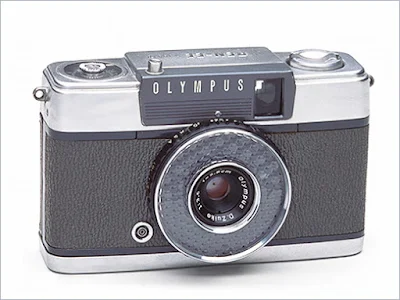 |
| Olympus Pen EE |
Launched in 1961, the emphasis of the Olympus Pen EE was on efficiency. Features include a fixed focus lens, shutter speeds of 1/40 and 1/200 sec., and automatic exposure adjustment. The Olympus Pen EE heralded the start of the programmable EE camera boom and is iconic in the success and popularity of the Pen cameras. Its evolution saw the introduction of newer and updated models over the years of development, including the Pen W (1964), Pen EE.2 (1968), and Pen EE.3 (1973).
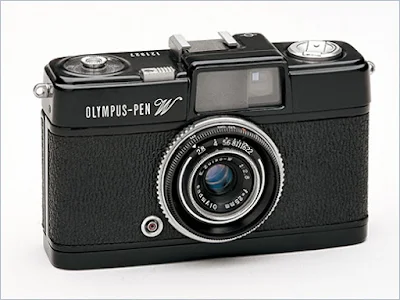 |
| Olympus Pen W |
The Pen W was designed specifically for wide-angle photography and comes with a wide-angle E.Zuiko 25mm F2.8 Lens.
 |
| Olympus Pen EE-3 |
The Pen EE.3 has a flashmatic system added. When used with the matching strobe (PS-200), the flashmatic system allowed the user to obtain a corrected aperture value by manually setting the aperture ring to the estimated distance. The lens was a D.Zuiko 28mm F3.5.
Olympus Pen EE.S (1962)
 |
| Olympus Pen EE.S |
Launched in 1962, the Olympus Pen EE.S came with a wider and faster D.Zuiko 30 mm F2.8 lens with shutter speeds still at 1/40 and 1/200 sec. A three-zone focus system was introduced to cater to the wider aperture lens.
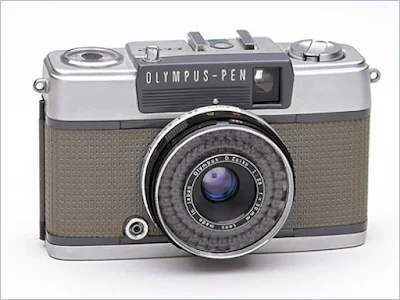 |
| Olympus Pen EES-2 |
The Pen EE.S2 (1968) had a film counter that reset automatically, it could use ASA400 high-speed film, and it came with a hot shoe.
Olympus Pen D (1962)
 |
| Olympus Pen D |
The Olympus Pen D was introduced in 1962 as the top model in the Olympus Pen range. Many professional features were packed into its compact body, including a high-performance F1.9 large-aperture lens and a high-speed 1/500 sec. Shutter, and a built-in exposure meter that allowed the direct reading of the LV.
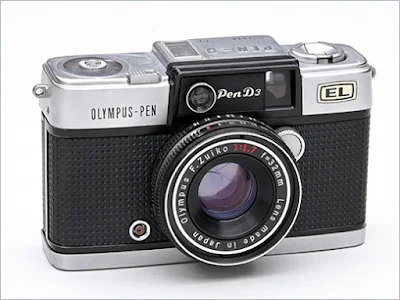 |
| Olympus Pen D3 |
The Pen D2 (1964) had an upgraded selenium cell exposure meter to a CdS system, and Pen D3 (1965) featured a wider-aperture F Zuiko 32mm F1.7 lens.
Olympus Pen EM (1965)
 |
| Olympus Pen EM |
The Olympus Pen EM went on sale in 1965 with three new features: an electronic shutter, automatic film advance, and automatic rewind. The electronic shutter allowed an exposure range of 30 sec. Down to 1/500 second, according to the brightness of the subject. Power for the shutter, film advance, and rewind systems was provided by two built-in AA batteries. Production of this model, however, ceased just after one year.
Olympus Pen F (1963)
 |
| Olympus Pen F |
The Olympus Pen F, introduced in 1963, was the world's first and only half-frame system single-lens reflex camera. The camera featured a Porro-prism finder and was the first to have a rotary titanium shutter. The Pen F system was complemented with a range of 20 interchangeable lenses. The Olympus Pen F was a revolutionary camera packed with innovative features. The rotary shutter, which combined speed with durability, was reportedly perfected only after a long and hard effort by Olympus engineers.
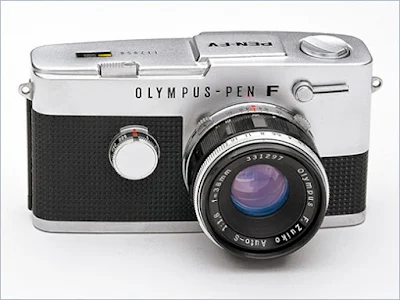 |
| Olympus Pen FV |
The Olympus Pen FV (1967) does not have the TTL exposure meter and M contact, and a CdS exposure meter coupled to the shutter dial was offered as an option.
Olympus Pen FT (1966)
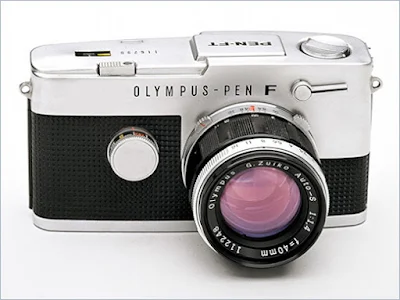 |
| Olympus Pen FT |
The Olympus PEN FT went on sale in 1966. Though identical to the Pen F in external appearance, it had a built-in TTL exposure meter. When the camera was pointed at a subject, the TTL number exposure control system displayed an aperture number in the viewfinder according to the shutter speed setting. The FT came with many enhancements over the original F, including a single-action film advance system and a built-in self-timer.
Olympus Pen EF (1981)
The Olympus Pen EF, the last in the series of half-frame cameras from Olympus, was a departure from the rest of the series. The model is manufactured only in black, with an outer skin of tough plastic, and comes with a flash unit that uses an AA battery to operate. The red-flag pop-up system is still present, but this can be overridden by setting the flash unit on.
The lens is a G.Zuiko 28mm f/3.5 lens with a focal range from 1.4 meters to infinity, and the programmed shutter mechanism range is from F3.5-1/30 sec. to F22-1/250 sec.
Malaysia's Online Marketplace for Vintage Film and Digital Cameras, Lenses,
and Camera Accessories. Follow
ImagingPixel on
Facebook, Pinterest, and X.














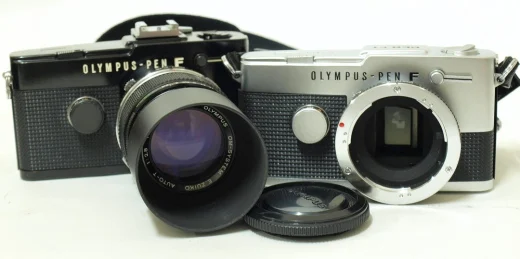












No comments:
Post a Comment